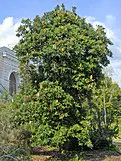Die Rote Bete, auch Rote Beete[1] (Opens in a new window)[2] (Opens in a new window) (von lateinisch (Opens in a new window) beta, Rübe, im 17. Jahrhundert aus dem Nd. (Opens in a new window) übernommen) oder Rote Rübe, in der Schweiz (Opens in a new window) Rande, in einigen Teilen Österreichs (Opens in a new window), Bayerns (Opens in a new window) und Südbadens (Opens in a new window) auch Rahne[3] (Opens in a new window) (Rauna, Rana, Rahne, Rohne, Rone, Ronen, Randig, Randich, Rohna) genannt, ist eine Kulturform der Rübe (Opens in a new window) und gehört zur Familie der ... Fuchsschwanzgewächse (Opens in a new window) (Amaranthaceae s. l., inklusive Gänsefußgewächse). Alle Kulturrüben werden heute in der Unterart Beta vulgaris subsp. vulgaris zusammengefasst, die Rote Bete zählt zur Conditiva-Gruppe (Opens in a new window).[4] (Opens in a new window) Frühere Synonyme (Opens in a new window) sind Beta vulgaris subsp. rapacea[5] (Opens in a new window) und Beta vulgaris subsp. vulgaris var. conditiva.[6] (Opens in a new window)
From today's featured article
Banksia serrata (Opens in a new window), the old man banksia, is a species of woody shrub (Opens in a new window) or tree in the family Proteaceae (Opens in a new window). It is found from Queensland (Opens in a new window) to Victoria (Opens in a new window), commonly growing as a gnarled tree up to 16 m (50 ft) in height, though it can be much smaller in more exposed areas. It has wrinkled grey bark and shiny dark green serrated leaves. The large yellow or greyish-yellow flower spikes (Opens in a new window) turn grey as they age, and pollinated flowers develop into large, grey, woody seed pods (Opens in a new window). This Banksia (Opens in a new window) species is one of four collected by Joseph Banks (Opens in a new window) in 1770, and one of four published in 1782 as part of Carl Linnaeus the Younger (Opens in a new window)'s original description of the genus. Throughout its range, it grows exclusively in sandy soils, and is usually the dominant plant where it grows in scrubland (Opens in a new window) or low woodland (Opens in a new window). B. serrata is pollinated (Opens in a new window) by and provides food for a wide array of vertebrate (Opens in a new window) and invertebrate (Opens in a new window) animals in the autumn and winter months. It is a common plant of parks and gardens. (Full article... (Opens in a new window))
